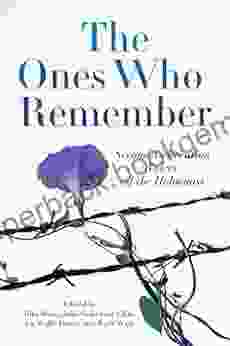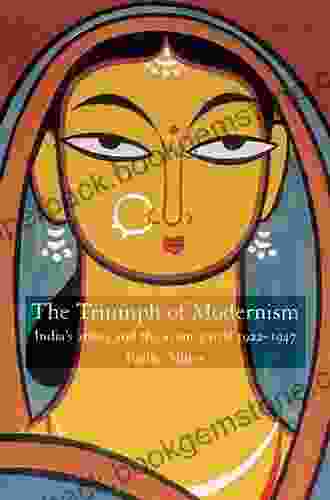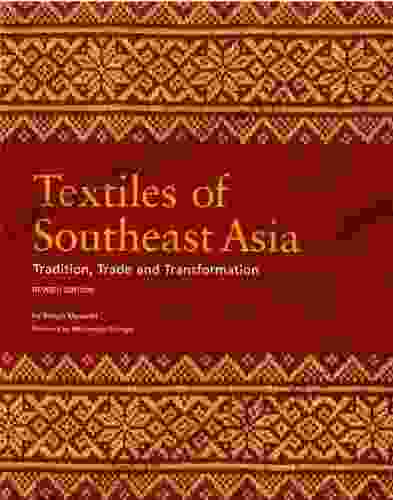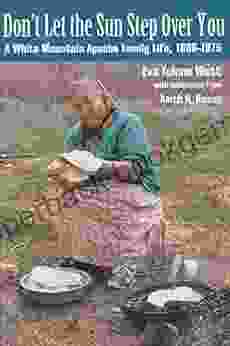Textiles of Southeast Asia: Trade, Tradition, and Transformation

Textiles hold a significant place in the cultural heritage and economic landscape of Southeast Asia. For centuries, the region has been a hub of textile production and trade, serving as a crossroads for ideas and techniques. This article explores the intricate world of Southeast Asian textiles, delving into their historical significance, traditional practices, and evolving contemporary trends.
4.7 out of 5
| Language | : | English |
| File size | : | 57937 KB |
| Text-to-Speech | : | Enabled |
| Screen Reader | : | Supported |
| Enhanced typesetting | : | Enabled |
| Print length | : | 432 pages |
Historical Context: A Tapestry of Trade
The origins of textile production in Southeast Asia can be traced back to prehistoric times. Archaeological evidence suggests that early communities in the region mastered the art of weaving, using locally sourced fibers like cotton, silk, and jute. As trade routes expanded during the Silk Road era, Southeast Asia became a key player in the global exchange of textiles.
Indian and Chinese traders introduced new techniques and design motifs, influencing the development of local textile industries. Over time, unique styles emerged in different regions, reflecting cultural diversity and environmental factors. For example, the ikat technique of dyeing yarn before weaving, originated in Indonesia and spread throughout the archipelago.
Traditional Practices: A Living Heritage
Traditionally, textile production in Southeast Asia was a cottage industry, with families passing down their skills from generation to generation. Natural fibers were harvested locally and processed by hand. Women played a central role in textile making, using looms to create elaborate designs.
Each region developed distinctive textile traditions. In Cambodia, ikat silk became renowned for its vibrant colors and geometric patterns. In Thailand, phasin silk is prized for its lightness and fluidity. Batik, a resist-dyeing technique, flourished in Indonesia, especially in Java and Bali.
Textiles were not merely functional items but also held cultural significance. They were used in religious ceremonies, weddings, and other important life events. Traditional motifs, such as temple designs or animal figures, were often woven into the fabric.
Contemporary Transformations: Embracing Modernity
In the 20th century, Southeast Asia underwent significant political, economic, and social changes. These transformations had a profound impact on the textile industry.
Industrialization led to the of mechanized production, increasing the efficiency and scale of textile manufacturing. However, this also posed challenges to traditional craftspeople who struggled to compete with mass-produced goods.
Globalization and increased travel exposed Southeast Asian textile makers to new ideas and markets. Designers began experimenting with traditional motifs and materials, creating contemporary interpretations of ancient techniques.
Contemporary Southeast Asian textiles reflect a vibrant fusion of tradition and innovation. Designers incorporate traditional patterns and motifs into modern silhouettes. Sustainable practices and the use of eco-friendly materials are gaining importance.
Textile making remains an important source of income for many Southeast Asian communities. Artisans are finding new ways to preserve traditional techniques while adapting to changing consumer preferences.
Economic and Cultural Significance
The textile industry is a significant contributor to the economies of Southeast Asian countries. Textile exports account for a substantial portion of GDP in countries like Cambodia, Indonesia, and Vietnam.
Beyond economic value, textiles play a crucial role in cultural identity and heritage. They are used in traditional rituals, festivals, and everyday life. Preserving textile traditions is essential for maintaining cultural diversity and passing on ancestral knowledge.
The textiles of Southeast Asia are a testament to the region's rich cultural heritage and vibrant trade networks. Traditional techniques and motifs have evolved over centuries, reflecting cultural diversity and environmental influences.
In the 21st century, Southeast Asian textiles continue to captivate the world with their beauty and craftsmanship. Designers and artisans are finding innovative ways to preserve tradition while embracing modernity, creating a tapestry of timeless artistry and contemporary expression.
4.7 out of 5
| Language | : | English |
| File size | : | 57937 KB |
| Text-to-Speech | : | Enabled |
| Screen Reader | : | Supported |
| Enhanced typesetting | : | Enabled |
| Print length | : | 432 pages |
Do you want to contribute by writing guest posts on this blog?
Please contact us and send us a resume of previous articles that you have written.
 Best Book
Best Book Page Flip
Page Flip Bookshelf
Bookshelf Literary loom
Literary loom Chapter
Chapter Bookish
Bookish PageTurner
PageTurner Bibliophile
Bibliophile Story
Story Inkwell
Inkwell Bookworm
Bookworm Labyrinth
Labyrinth Plot Twist
Plot Twist Prose
Prose Paperback
Paperback Storyteller
Storyteller Sanctuary
Sanctuary Fiction
Fiction Reading
Reading Chronicle
Chronicle Read
Read Mary Peters
Mary Peters Becky Gilhespie
Becky Gilhespie Maurice Samuels
Maurice Samuels Nancy Kress
Nancy Kress Ben Coes
Ben Coes J C Sum
J C Sum Michael Winter
Michael Winter Eddie Chambers
Eddie Chambers Theda Perdue
Theda Perdue Ebony Diamonds
Ebony Diamonds Brad Bussie
Brad Bussie Terry Pratchett
Terry Pratchett Hillary Jordan
Hillary Jordan Bj Wane
Bj Wane Tessa Miller
Tessa Miller James S A Corey
James S A Corey Koloman Moser
Koloman Moser Justin Woolley
Justin Woolley Keith Houston
Keith Houston John Scarne
John Scarne John Muir
John Muir Ben J Harris
Ben J Harris Mateo Askaripour
Mateo Askaripour Diane Tuckman
Diane Tuckman Bethany C Morrow
Bethany C Morrow Greg Mitchell
Greg Mitchell Taylor Jenkins Reid
Taylor Jenkins Reid Betsy Beier
Betsy Beier Michael Mammay
Michael Mammay Bob Elliott
Bob Elliott Barbara Totaro
Barbara Totaro Ben Eastham
Ben Eastham Yahrah St John
Yahrah St John Shoko Tendo
Shoko Tendo Jonathan Waterman
Jonathan Waterman Bandana Ojha
Bandana Ojha Sophia Rolle
Sophia Rolle Mary Brave Bird
Mary Brave Bird Elissa Washuta
Elissa Washuta Ruth Silvestre
Ruth Silvestre Jane Pek
Jane Pek Barry Moser
Barry Moser Laurie Gough
Laurie Gough Barbara Davis
Barbara Davis Leon Smith
Leon Smith Ben Box
Ben Box Jennie Smallenbroek
Jennie Smallenbroek Zora O Neill
Zora O Neill Dean Koontz
Dean Koontz Mary Lou Andre
Mary Lou Andre Ernst Rettelbusch
Ernst Rettelbusch Ibl Press
Ibl Press Marie Beardmore
Marie Beardmore Jonathan C Slaght
Jonathan C Slaght Barbara Chase Riboud
Barbara Chase Riboud Gary Wasserman
Gary Wasserman Yvonne Blackwood
Yvonne Blackwood Tya Marie
Tya Marie Billie Rae Bates
Billie Rae Bates Deanne Stillman
Deanne Stillman Robert Roskind
Robert Roskind John Seed
John Seed Milind Mulick
Milind Mulick C Pierce Salguero
C Pierce Salguero Lucinda Fleeson
Lucinda Fleeson Eric Rauchway
Eric Rauchway Hayao Miyazaki
Hayao Miyazaki Bonnie Barker
Bonnie Barker Staci Swider
Staci Swider Marty Noble
Marty Noble Harvey Arden
Harvey Arden Bernice Lerner
Bernice Lerner Tim Rangnow
Tim Rangnow Ruth Superhal
Ruth Superhal Jules Verne
Jules Verne Norman Lee
Norman Lee Michael J Hayde
Michael J Hayde Collins Dictionaries
Collins Dictionaries Fania E Davis
Fania E Davis Beau Riffenburgh
Beau Riffenburgh Theo Farrington
Theo Farrington Michael Anderle
Michael Anderle Barry Lord
Barry Lord Betsy Whyte
Betsy Whyte Margaret Kessler
Margaret Kessler Hope Hart
Hope Hart Zongyan Hu
Zongyan Hu Toni Ann Johnson
Toni Ann Johnson Khadijah J
Khadijah J Tori Rodriguez
Tori Rodriguez Michael Haag
Michael Haag Bill Winner
Bill Winner Steve Ryfle
Steve Ryfle Barry Herniman
Barry Herniman Harmon Cooper
Harmon Cooper Maggie Craft
Maggie Craft Deborah Forman
Deborah Forman Tom Wilson
Tom Wilson Bella Martin
Bella Martin Bianca Del Rio
Bianca Del Rio Jessica Marting
Jessica Marting Boris Mihailovic
Boris Mihailovic Yiyun Li
Yiyun Li Lonely Planet
Lonely Planet Joseph M Henninger
Joseph M Henninger Umm Zakiyyah
Umm Zakiyyah Benjamin Hochman
Benjamin Hochman Wendy Tait
Wendy Tait Maxime J Durand
Maxime J Durand Barry Kirwan
Barry Kirwan Mario Rizzi
Mario Rizzi Barbara Grizzuti Harrison
Barbara Grizzuti Harrison Bebe Harper
Bebe Harper Lucy Jane Bledsoe
Lucy Jane Bledsoe Stephen Mills
Stephen Mills Bill Bensley
Bill Bensley Elaine A Clark
Elaine A Clark Bill Plympton
Bill Plympton Benjamin E Wise
Benjamin E Wise Chris Roel
Chris Roel Charlie Jane Anders
Charlie Jane Anders Bobby Brown
Bobby Brown Tom Wiener
Tom Wiener Vanessa Zoltan
Vanessa Zoltan Joseph Lanza
Joseph Lanza Dean A Kowalski
Dean A Kowalski Pam Flowers
Pam Flowers Carol Sulcoski
Carol Sulcoski Sheila Montilla
Sheila Montilla Bill Lee
Bill Lee Robert Lanz
Robert Lanz Kerry Bogert
Kerry Bogert Partha Mitter
Partha Mitter Josephine B Pasquarello
Josephine B Pasquarello Kathy Mckeon
Kathy Mckeon Dennis E Taylor
Dennis E Taylor Paul S Leland
Paul S Leland James Haddock
James Haddock Grace Berry
Grace Berry Steven Campbell
Steven Campbell Bella Blair
Bella Blair Ceidrik Heward
Ceidrik Heward Barbara Raue
Barbara Raue Jan V White
Jan V White Merl Code
Merl Code Donald N Thompson
Donald N Thompson Beth Tondreau
Beth Tondreau Michael Doyle
Michael Doyle Eric Gibson
Eric Gibson Tiana Bighorse
Tiana Bighorse Sara Boccaccini Meadows
Sara Boccaccini Meadows Tammy Ruggles
Tammy Ruggles Samuel Peralta
Samuel Peralta Poppy Evans
Poppy Evans Betsy Dillard Stroud
Betsy Dillard Stroud Claude Lanzmann
Claude Lanzmann Nolan Clark
Nolan Clark Charles Sturt
Charles Sturt Dave Hickey
Dave Hickey Mariana Atencio
Mariana Atencio Blake Farha
Blake Farha Stewart M Green
Stewart M Green Barbara Miller
Barbara Miller Basil Johnston
Basil Johnston Brad Taylor
Brad Taylor Joan Williams
Joan Williams Tershia Lambrechts
Tershia Lambrechts Dave Hill
Dave Hill Malala Yousafzai
Malala Yousafzai Noret Flood
Noret Flood Philip B Meggs
Philip B Meggs Barry Sonnenfeld
Barry Sonnenfeld Gabrielle Hamilton
Gabrielle Hamilton Kristen Dutkiewicz
Kristen Dutkiewicz Jennifer Sewing
Jennifer Sewing Ulysses S Grant
Ulysses S Grant Robert Crais
Robert Crais Yoshitaka Amano
Yoshitaka Amano J P Telotte
J P Telotte Tim Powers
Tim Powers Orestes Lorenzo
Orestes Lorenzo Basilius Besler
Basilius Besler D A Miller
D A Miller Dalili
Dalili Doug Risner
Doug Risner Sarah Mirk
Sarah Mirk Charlotte Fiell
Charlotte Fiell Barbara Demick
Barbara Demick James Goddard
James Goddard Lucy Adlington
Lucy Adlington Charlise Lyles
Charlise Lyles Bet Borgeson
Bet Borgeson Larissa Pham
Larissa Pham Bob Drury
Bob Drury Bonny Snowdon
Bonny Snowdon S L Rowland
S L Rowland Noel Riley Fitch
Noel Riley Fitch Tyler Perry
Tyler Perry Barack Obama
Barack Obama John H Vanderpoel
John H Vanderpoel Richard L Leza Sr
Richard L Leza Sr Gerri Leen
Gerri Leen Deirdre Slattery
Deirdre Slattery Simon Turney
Simon Turney Benj Pasek
Benj Pasek Benjamin John Coleman
Benjamin John Coleman David Byrne
David Byrne Elisabeth Elliot
Elisabeth Elliot Gillian Gloyer
Gillian Gloyer Jon Contino
Jon Contino Tim Rayborn
Tim Rayborn David Airey
David Airey Denis Dutton
Denis Dutton Fiona Peart
Fiona Peart Erica Davies
Erica Davies Russell Foureagles
Russell Foureagles William Alexander
William Alexander Rita Benn
Rita Benn Robert E Hampson
Robert E Hampson Barrington Barber
Barrington Barber B V Larson
B V Larson Shanora Williams
Shanora Williams Benjamin Lewin
Benjamin Lewin Seymour Morris Jr
Seymour Morris Jr Sarah Birnbach
Sarah Birnbach Greg O Brien
Greg O Brien Lowell Angell
Lowell Angell Lisa Congdon
Lisa Congdon Becky Chambers
Becky Chambers Rexford Govorchin
Rexford Govorchin Joseph Doddridge
Joseph Doddridge Bac Hoai Tran
Bac Hoai Tran Beverly Jenkins
Beverly Jenkins Barbara A Parish
Barbara A Parish Ben Corbett
Ben Corbett Talia Hibbert
Talia Hibbert Dana Fox
Dana Fox Hal Erickson
Hal Erickson Sarah Hepola
Sarah Hepola Maggie Ramsay
Maggie Ramsay Eliot Greenspan
Eliot Greenspan Steve Berry
Steve Berry Rainer Maria Rilke
Rainer Maria Rilke Matt Smith
Matt Smith James Ulyatt
James Ulyatt Tim W Jackson
Tim W Jackson Philip Guston
Philip Guston Linda Lael Miller
Linda Lael Miller Joan Reardon
Joan Reardon Jenna Fischer
Jenna Fischer Darrel Rees
Darrel Rees Bob Normand
Bob Normand Jack Finney
Jack Finney Bette Howland
Bette Howland Ben D Over
Ben D Over Marvin Patchen
Marvin Patchen Jessie Knadler
Jessie Knadler Terese Marie Mailhot
Terese Marie Mailhot Bev Sellars
Bev Sellars Sergio Toppi
Sergio Toppi Tony Burton
Tony Burton Lynne Anne Blom
Lynne Anne Blom D L Harrison
D L Harrison Diane Duane
Diane Duane Saul Tanpepper
Saul Tanpepper Elisabeth Stevens
Elisabeth Stevens Wassily Kandinsky
Wassily Kandinsky Cornelius C Kubler
Cornelius C Kubler Betsy Prioleau
Betsy Prioleau Bernice L Mcfadden
Bernice L Mcfadden Helmut Kopka
Helmut Kopka Clifford D Simak
Clifford D Simak Beatrice Sonders
Beatrice Sonders Jacinda Townsend
Jacinda Townsend Maura Spiegel
Maura Spiegel David Fisher
David Fisher Diane Gensler
Diane Gensler Brent Eviston
Brent Eviston Robert Henderson
Robert Henderson Jamie Carter
Jamie Carter Valerie L Winslow
Valerie L Winslow Chris Nashawaty
Chris Nashawaty Jeremy Dronfield
Jeremy Dronfield Sophie Cunningham
Sophie Cunningham Stephen C Baldwin
Stephen C Baldwin Keith Doyle
Keith Doyle Gavin Maxwell
Gavin Maxwell John Mulholland
John Mulholland Tony Horwitz
Tony Horwitz Lena Corwin
Lena Corwin Carol Huber Cypher
Carol Huber Cypher Nick Petrie
Nick Petrie Bonny Pierce Lhotka
Bonny Pierce Lhotka Chad Zunker
Chad Zunker George H Gisser
George H Gisser Veda Austin
Veda Austin Briana Wiles
Briana Wiles Hakeem M Oluseyi
Hakeem M Oluseyi Rebecca Sugar
Rebecca Sugar Nikki Turner
Nikki Turner Bassey Ikpi
Bassey Ikpi Behrouz Boochani
Behrouz Boochani Phillip Maisel
Phillip Maisel Matthew Brehm
Matthew Brehm Beebe Bahrami
Beebe Bahrami Silvia Marina Arrom
Silvia Marina Arrom Matthew J Milliner
Matthew J Milliner Kevin Hart
Kevin Hart Bley Hack
Bley Hack Joanne Hutchinson
Joanne Hutchinson Terry Lee Stone
Terry Lee Stone Bob Herbert
Bob Herbert Ella Frances Sanders
Ella Frances Sanders Jane L Rosen
Jane L Rosen Robert Morkot
Robert Morkot Edward White
Edward White Ruby Dixon
Ruby Dixon Ian Nathan
Ian Nathan Monica Walters
Monica Walters Bengie Molina
Bengie Molina Rosemary Kimani
Rosemary Kimani Kayla Arora
Kayla Arora Sejal Shah
Sejal Shah Nefertiti Austin
Nefertiti Austin Bart King
Bart King Wayne Moniz
Wayne Moniz Michael Chatfield
Michael Chatfield Marie Killilea
Marie Killilea Marina Warner
Marina Warner Dan Moren
Dan Moren Bernth Lindfors
Bernth Lindfors Tom Sito
Tom Sito John Howard Griffin
John Howard Griffin Iris Murdoch
Iris Murdoch Wayne Larsen
Wayne Larsen Leanne Kitchen
Leanne Kitchen Individual Way
Individual Way Hildegarde Mahoney
Hildegarde Mahoney Barbara Bradley
Barbara Bradley Momoyo Nishimura
Momoyo Nishimura Conn Iggulden
Conn Iggulden Barbara Hambly
Barbara Hambly Roman Mars
Roman Mars Catherine Ryan Hyde
Catherine Ryan Hyde Ben Strand
Ben Strand Brad Lee
Brad Lee Bill H Myers
Bill H Myers Barbie Scott
Barbie Scott Bruce Hanington
Bruce Hanington Lauren Meisner
Lauren Meisner William A Kappele
William A Kappele William Black
William Black Ian Chilvers
Ian Chilvers Nelson Demille
Nelson Demille Eva Tulene Watt
Eva Tulene Watt Jonathan Lopez
Jonathan Lopez Thomas P Stafford
Thomas P Stafford Ea Hooper
Ea Hooper Zachary Leader
Zachary Leader Birgit O Connor
Birgit O Connor Brandon Varnell
Brandon Varnell Douglas Brooke Wheelton Sladen
Douglas Brooke Wheelton Sladen Michael Wise
Michael Wise Lexi Sundell
Lexi Sundell Jodi Staniunas Hopper
Jodi Staniunas Hopper Susan Herrmann Loomis
Susan Herrmann Loomis Spencer Shaw
Spencer Shaw Bayard Taylor
Bayard Taylor Edward Gibbon
Edward Gibbon Jpinsiders
Jpinsiders Ellen Tomaszewski
Ellen Tomaszewski Jonathan Strahan
Jonathan Strahan Dan Dietz
Dan Dietz William Lidwell
William Lidwell Kao Kalia Yang
Kao Kalia Yang David E Lowe
David E Lowe Benjamin Drake
Benjamin Drake Richard Sorger
Richard Sorger Beverly J Armento
Beverly J Armento Stephen Haff
Stephen Haff Tiana Laveen
Tiana Laveen David Elliot Cohen
David Elliot Cohen Ben Shahn
Ben Shahn Ottessa Moshfegh
Ottessa Moshfegh Thomas S Hischak
Thomas S Hischak Matthew Luzi
Matthew Luzi James Joyce
James Joyce Elena Gorokhova
Elena Gorokhova Laney Salisbury
Laney Salisbury Kolbie Blume
Kolbie Blume Ken Browar
Ken Browar Louis Wain
Louis Wain Helen Hoang
Helen Hoang Barbara Delinsky
Barbara Delinsky Mark Tufo
Mark Tufo Mike Curato
Mike Curato Baby Professor
Baby Professor Mackenzie Phillips
Mackenzie Phillips Katja Petrowskaja
Katja Petrowskaja Patricia Sands
Patricia Sands Steve Huston
Steve Huston Barney Nelson
Barney Nelson Jamie Davis
Jamie Davis Ian Mcdonald
Ian Mcdonald Bill Bryson
Bill Bryson Phoebe Robinson
Phoebe Robinson Joseph Heywood
Joseph Heywood Bolu Babalola
Bolu Babalola Helen Thorpe
Helen Thorpe Florencia E Mallon
Florencia E Mallon Linda Nochlin
Linda Nochlin Alan O Brien
Alan O Brien Daniel Rachel
Daniel Rachel Eric Henze
Eric Henze Barbara Casey
Barbara Casey Micah Ian Wright
Micah Ian Wright Laura Furman
Laura Furman Ros Per
Ros Per Bob Leszczak
Bob Leszczak Charles A Perrone
Charles A Perrone Lynne Olson
Lynne Olson F Scott Fitzgerald
F Scott Fitzgerald Jenny Mckay
Jenny Mckay Mary Matsuda Gruenewald
Mary Matsuda Gruenewald C J Boyle
C J Boyle Paul Kendall
Paul Kendall Debbie Rose Myers
Debbie Rose Myers Baoshu
Baoshu Betty Dooley Awbrey
Betty Dooley Awbrey Jordan Marie
Jordan Marie Mark Crilley
Mark Crilley Jason Sperb
Jason Sperb John G Breslin
John G Breslin Ben Street
Ben Street Ian J Malone
Ian J Malone Interweave Editors
Interweave Editors Bil Donovan
Bil Donovan William Ellis
William Ellis Esmeralda Santiago
Esmeralda Santiago Beryl Markham
Beryl Markham Faye Kellerman
Faye Kellerman Bob Martin
Bob Martin Brian Burke
Brian Burke Kenya Hunt
Kenya Hunt Wilkie Collins
Wilkie Collins Lorraine De Meaux
Lorraine De Meaux Bella Young
Bella Young Billie Holiday
Billie Holiday James Grady
James Grady Laura Ling
Laura Ling Nathalie Kalbach
Nathalie Kalbach Betty Halbreich
Betty Halbreich Ravyn Wilde
Ravyn Wilde Stephanie Claytor
Stephanie Claytor Ashley Jaquavis
Ashley Jaquavis Peter Ustinov
Peter Ustinov Blair Howard
Blair Howard Saxon Andrew
Saxon Andrew Sir Richard Francis Burton
Sir Richard Francis Burton Bob Dennard
Bob Dennard Bill Cotter
Bill Cotter John E Siers
John E Siers Blakely Little
Blakely Little Lori Wilde
Lori Wilde Rohan M Vider
Rohan M Vider Peter Inglis
Peter Inglis Loring M Danforth
Loring M Danforth Robin Cormack
Robin Cormack Dori Jones Yang
Dori Jones Yang Bob Dow
Bob Dow Robert Muirhead
Robert Muirhead George Lopez
George Lopez Lesley Downer
Lesley Downer Katie Dowe
Katie Dowe Olive Yong
Olive Yong Blaise Corvin
Blaise Corvin Laurent Bolard
Laurent Bolard Bich Minh Nguyen
Bich Minh Nguyen Wesley Jones
Wesley Jones Leo Buijs
Leo Buijs Tove Ditlevsen
Tove Ditlevsen Bill Arnott
Bill Arnott Ben Hannam
Ben Hannam Tracey Lange
Tracey Lange George Schindler
George Schindler Sandra Duran Wilson
Sandra Duran Wilson J Dominique
J Dominique Stanislaw Lem
Stanislaw Lem Stephen Boss
Stephen Boss Chevonne Clarke Bryan
Chevonne Clarke Bryan Patrick Symmes
Patrick Symmes Jay Armstrong
Jay Armstrong Suzette Riddick
Suzette Riddick David V Jervis
David V Jervis Tim Stokes
Tim Stokes Glynn Stewart
Glynn Stewart Colin Falconer
Colin Falconer Gabrielle Euvino
Gabrielle Euvino John Ruskin
John Ruskin Paula Kamen
Paula Kamen Barbara Lewis
Barbara Lewis Melissa Rivers
Melissa Rivers Christopher Butler
Christopher Butler Terry Compton
Terry Compton Ilan Stavans
Ilan Stavans Emily Spivack
Emily Spivack Matthew Morgante
Matthew Morgante Lucee Joie
Lucee Joie Shane Mitchell
Shane Mitchell Shing Schih
Shing Schih Philip Ball
Philip Ball Stuart Williams
Stuart Williams Mitche Graf
Mitche Graf Stuart D Paine
Stuart D Paine Michael Shaara
Michael Shaara Kyle Froman
Kyle Froman Shirtaloon
Shirtaloon Paraluman S Aspillera
Paraluman S Aspillera Becky Stephen
Becky Stephen Jennifer Wilson
Jennifer Wilson
Light bulbAdvertise smarter! Our strategic ad space ensures maximum exposure. Reserve your spot today!

 Brady MitchellScott and Larry's Excellent Adventure: A Journey Through the World of SEO and...
Brady MitchellScott and Larry's Excellent Adventure: A Journey Through the World of SEO and...
 Todd TurnerUncover the Enchanting Allure of Charleston and Savannah with Lonely Planet's...
Todd TurnerUncover the Enchanting Allure of Charleston and Savannah with Lonely Planet's... Nathaniel HawthorneFollow ·7.5k
Nathaniel HawthorneFollow ·7.5k Joel MitchellFollow ·19.3k
Joel MitchellFollow ·19.3k Felipe BlairFollow ·9.8k
Felipe BlairFollow ·9.8k Kendall WardFollow ·19.7k
Kendall WardFollow ·19.7k Phil FosterFollow ·3.3k
Phil FosterFollow ·3.3k Xavier BellFollow ·15.3k
Xavier BellFollow ·15.3k Roberto BolañoFollow ·16.5k
Roberto BolañoFollow ·16.5k Kelly BlairFollow ·15.8k
Kelly BlairFollow ·15.8k

 Bryan Gray
Bryan GrayThe Second Generation: Voices of the Holocaust
The Holocaust was one of the most horrific...

 Douglas Foster
Douglas FosterWalking the Fields of the Newfoundland Dead
In the heart of the rolling countryside of...

 Henry James
Henry JamesThe Unsanctioned Asset: A Gripping Thriller Set in a...
In the realm of espionage thrillers, The...

 Devon Mitchell
Devon MitchellPainting En Plein Air: Capturing the Essence of Nature on...
Painting en plein air, or painting...

 Damon Hayes
Damon HayesThe Life and Times of Dene Residential School Survivor
Residential schools...

 Steve Carter
Steve CarterIndia Artists and the Avant Garde: 1922-1947
The term "avant-garde" is...
4.7 out of 5
| Language | : | English |
| File size | : | 57937 KB |
| Text-to-Speech | : | Enabled |
| Screen Reader | : | Supported |
| Enhanced typesetting | : | Enabled |
| Print length | : | 432 pages |








